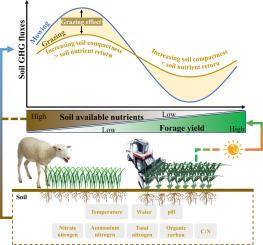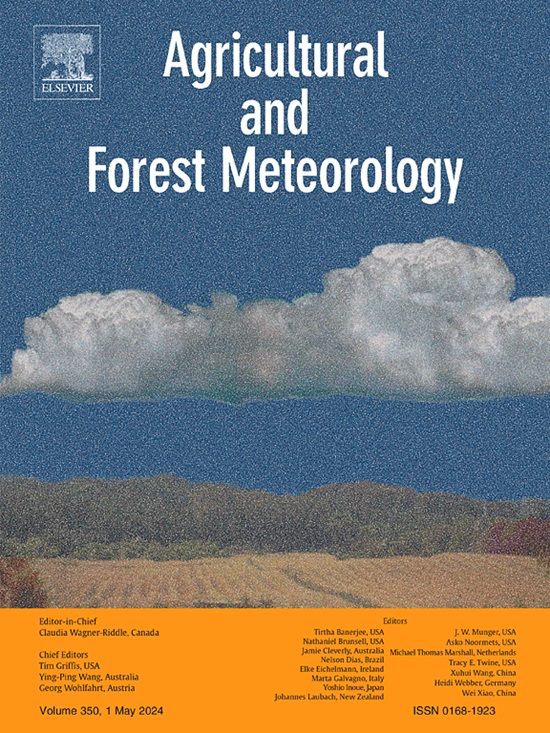Grazing mitigates soil GHG emissions while optimizes forage production of annual cereal grasses in an arid saline-alkali land
IF 5.7
1区 农林科学
Q1 AGRONOMY
引用次数: 0
Abstract
Livestock production faces the challenge of feed shortage due to the escalating demand for livestock products and the continued degradation of grasslands. The cultivation of annual forage crops may be an alternative option in the forthcoming decades. However, the impact of grassland utilization method (grazing vs. mowing) on forage yield and associated soil greenhouse gas (GHG) emissions of annual sown pastures remains uncertain. A 4-year experiment was conducted in a saline-alkali cropland with irrigation of 560 mm yr-1 in Northwest China. Annual forage crops were rotationally sown to elucidate the impact of grassland utilization methods on forage productivity (hay, crude protein (CP)) and soil GHG (CO2, N2O, and CH4) fluxes, aiming to optimize the trade-off between forage production and soil GHG emissions. Results show that compared to mowing, grazing increased the mean yields of hay and CP by 44.7 % and 50.2 %, respectively; however, grazing had no significant impact on the cumulative soil N2O emissions and CH4 uptake but significantly reduced cumulative soil CO2 emissions during the last two study years. For both grazing and mowing, soil water content was the primary influencing factor of soil N2O emissions, and soil temperature was the primary influencing factor of soil CH4 uptakes and CO2 emissions. Cumulative soil N2O emissions and CH4 uptakes had upward trends with the increasing forage hay and CP yields under grazing. Cumulative soil CO2 emission under mowing had a downward-curving relationship with the hay and CP yields. Overall, compared to mowing, grazing decreased hay and CP yield-scaled soil GHG intensity by 36.3 % and 38.6 % respectively. Grazing presents an effective strategy for optimizing forage production and environmental performance of annual cereal grasses in arid regions.


放牧减轻了土壤温室气体排放,同时优化了干旱盐碱地一年生谷物的饲料生产
由于对畜产品需求的不断增加和草原的持续退化,畜牧业生产面临饲料短缺的挑战。在未来几十年,种植一年生饲料作物可能是另一种选择。然而,不同草地利用方式(放牧与刈割)对年播牧草产草量及相关土壤温室气体(GHG)排放的影响尚不确定。在西北某盐碱地进行了4年试验,灌溉面积为560 mm /年。为了研究不同草地利用方式对牧草生产力(干草、粗蛋白质(CP))和土壤温室气体(CO2、N2O和CH4)通量的影响,优化牧草生产与土壤温室气体排放之间的平衡。结果表明:与刈割相比,放牧使牧草和CP的平均产量分别提高44.7%和50.2%;放牧对土壤N2O和CH4的累积排放没有显著影响,但显著降低了土壤CO2的累积排放。无论是放牧还是刈割,土壤含水量都是影响土壤N2O排放的主要因素,土壤温度是影响土壤CH4吸收和CO2排放的主要因素。放牧条件下,随着牧草和CP产量的增加,土壤累积N2O排放和CH4吸收量呈上升趋势。刈割条件下土壤累积CO2排放量与干草和CP产量呈下降曲线关系。总体而言,与刈割相比,放牧使干草和CP产量土壤温室气体强度分别降低36.3%和38.6%。放牧是优化干旱区一年生谷类牧草产量和环境绩效的有效策略。
本文章由计算机程序翻译,如有差异,请以英文原文为准。
求助全文
约1分钟内获得全文
求助全文
来源期刊
CiteScore
10.30
自引率
9.70%
发文量
415
审稿时长
69 days
期刊介绍:
Agricultural and Forest Meteorology is an international journal for the publication of original articles and reviews on the inter-relationship between meteorology, agriculture, forestry, and natural ecosystems. Emphasis is on basic and applied scientific research relevant to practical problems in the field of plant and soil sciences, ecology and biogeochemistry as affected by weather as well as climate variability and change. Theoretical models should be tested against experimental data. Articles must appeal to an international audience. Special issues devoted to single topics are also published.
Typical topics include canopy micrometeorology (e.g. canopy radiation transfer, turbulence near the ground, evapotranspiration, energy balance, fluxes of trace gases), micrometeorological instrumentation (e.g., sensors for trace gases, flux measurement instruments, radiation measurement techniques), aerobiology (e.g. the dispersion of pollen, spores, insects and pesticides), biometeorology (e.g. the effect of weather and climate on plant distribution, crop yield, water-use efficiency, and plant phenology), forest-fire/weather interactions, and feedbacks from vegetation to weather and the climate system.

 求助内容:
求助内容: 应助结果提醒方式:
应助结果提醒方式:


